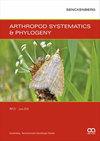Systematics, phylogeny, and taphonomy of ghost shrimps (Decapoda): a perspective from the fossil record.
IF 1.8
2区 农林科学
Q2 ENTOMOLOGY
引用次数: 44
Abstract
Ghost shrimps of Callianassidae and Ctenochelidae are soft-bodied, usually heterochelous decapods representing major bioturbators of muddy and sandy (sub)marine substrates. Ghost shrimps have a robust fossil record spanning from the Early Cretaceous (~ 133 Ma) to the Holocene and their remains are present in most assemblages of Cenozoic decapod crustaceans. Their taxonomic interpretation is in flux, mainly because the generic assignment is hindered by their insufficient preservation and disagreement in the biological classification. Furthermore, numerous taxa are incorrectly classified within the catch-all taxon Callianassa. To show the historical patterns in describing fossil ghost shrimps and to evaluate taphonomic aspects influencing the attribution of ghost shrimp remains to higher level taxa, a database of all fossil species treated at some time as belonging to the group has been compiled: 250 / 274 species are considered valid ghost shrimp taxa herein. More than half of these taxa (160 species, 58.4%) are known only from distal cheliped elements, i.e., dactylus and / or propodus, due to the more calcified cuticle locally. Rarely, ghost shrimps are preserved in situ in burrows or in direct association with them, and several previously unpublished occurrences are reported herein. For generic assignment, fossil material should be compared to living species because many of them have modern relatives. Heterochely, intraspecific variation, ontogenetic changes and sexual dimorphism are all factors that have to be taken into account when working with fossil ghost shrimps. Distal elements are usually more variable than proximal ones. Preliminary results suggest that the ghost shrimp clade emerged not before the Hauterivian (~ 133 Ma). The divergence of Ctenochelidae and Paracalliacinae is estimated to occur within the interval of Hauterivian to Albian (133-100 Ma). Callichirinae and Eucalliacinae likely diverged later during the Late Cretaceous (100-66 Ma), whereas Callianassinae did not appear before the Eocene (56 Ma).鬼虾(十足目)的系统学、系统发育和分类:从化石记录的角度看。
虾蛄科和虾蛄科的虾蛄是软体动物,通常是异螯十足动物,代表了泥质和砂质(海底)底物的主要生物扰动者。鬼虾的化石记录从早白垩世(~ 133 Ma)到全新世都有,在大多数新生代十足甲壳类动物的组合中都有鬼虾的遗骸。它们的分类学解释一直在不断变化,主要是由于它们的保存不足和生物分类上的分歧阻碍了属归属的确定。此外,许多分类群被错误地归为“包罗万象”分类群Callianassa。为了揭示鬼怪虾化石描述的历史规律,并评价影响鬼怪虾遗存归属于更高层次分类群的地学因素,本文建立了鬼怪虾化石类群的数据库,其中250 / 274种被认为是有效的鬼怪虾分类群。这些分类群中有超过一半(160种,58.4%)仅来自远端足趾类,即趾足类和/或原足类,因为局部的角质层钙化程度更高。很少,鬼虾被保存在洞穴中或与它们直接相关,这里报告了几个以前未发表的事件。对于属划分,化石材料应该与现存物种进行比较,因为它们中的许多都有现代的亲戚。异源性、种内变异、个体发生变化和两性二态性都是研究鬼虾化石时必须考虑的因素。远端骨元通常比近端骨元更易变。初步结果表明,鬼虾分支出现在Hauterivian (~ 133 Ma)之前。据估计,栉水母科和副栉水母科的分化发生在Hauterivian至Albian (133-100 Ma)之间。Callichirinae和Eucalliacinae可能在晚白垩世(100-66 Ma)出现分化,而Callianassinae在始新世(56 Ma)之前没有出现。
本文章由计算机程序翻译,如有差异,请以英文原文为准。
求助全文
约1分钟内获得全文
求助全文
来源期刊

Arthropod Systematics & Phylogeny
Agricultural and Biological Sciences-Insect Science
CiteScore
2.50
自引率
5.60%
发文量
26
审稿时长
12 weeks
期刊介绍:
Arthropod Systematics & Phylogeny releases three times per year. Research fields covered are the taxonomy, morphology/anatomy, phylogeny (molecular or morphology-based), historical biogeography and palaeontology of arthropod taxa.
Arthropod Systematics & Phylogeny is the successor of Entomologische Abhandlungen, formerly published by the Museum of Zoology Dresden, Germany.
 求助内容:
求助内容: 应助结果提醒方式:
应助结果提醒方式:


